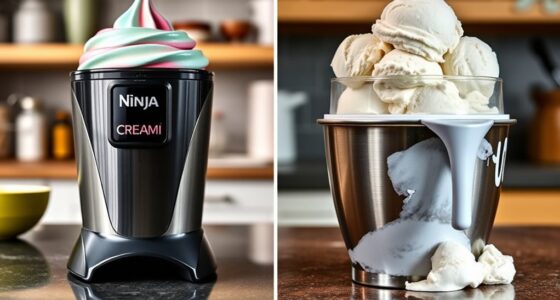To keep your coffee grinder in prime shape, clean it regularly to prevent oils and residue from affecting flavor. Use soft brushes, damp cloths, and special cleaner tablets to deep clean burrs or blades weekly, and wipe down the hopper to reduce oil buildup. Schedule monthly deep cleans and quarterly inspections for ideal performance. With consistent maintenance, you’ll enjoy fresher coffee and extend your grinder’s lifespan—discover more tips and tricks as you continue.
Key Takeaways
- Regularly disassemble and clean burrs or blades to prevent oil buildup and maintain consistent grind quality.
- Use soft brushes, damp cloths, and grinder cleaner tablets for thorough internal cleaning.
- Wipe hopper and exterior parts frequently to remove coffee oils and residue.
- Schedule weekly internal cleanings and monthly deep cleans for optimal performance.
- Monitor signs like inconsistent grinds or unusual noises to identify when maintenance is needed.

Maintaining your coffee grinder is vital for guaranteeing the best flavor and performance. When you clean your grinder regularly, you prevent stale and rancid flavors from tainting your coffee, preserving its fresh aroma and taste. A clean grinder also runs more efficiently, reducing the risk of clogs and ensuring that your grind size remains consistent. This not only improves the quality of your brew but also extends the lifespan of your equipment by minimizing wear and tear on the components. Additionally, routine cleaning enhances safety by preventing overheating or electrical issues that can arise from accumulated debris. Keeping your grinder hygienic by removing old coffee oils and residues also helps maintain a clean environment and prevents mold or bacteria growth.
Regular cleaning preserves your coffee’s flavor, efficiency, and lifespan by removing oils, residues, and debris.
You’ll know it’s time for maintenance when you notice visible residue, such as oily coffee oils or grounds clinging to the burrs or blades. Off-color grinds or inconsistent grind sizes when switching beans can also be signs that your grinder needs attention. Unusual noises during operation, difficulty adjusting grind settings, or slower grinding speeds indicate that cleaning or part inspection is overdue. Even if your coffee tastes stale despite using fresh beans, it’s a strong sign you should give your grinder a thorough clean. Regularly inspecting your equipment helps identify potential issues early, prolonging its lifespan.
For burr grinders, disassembling the burr mechanism allows for deep cleaning. Use soft brushes or toothbrushes to remove larger coffee particles, and wipe oily residues with damp cloths. Specialized grinder cleaner tablets are excellent for chemical cleaning of internal parts, ensuring that oils and residues are fully removed. Make sure all parts are completely dry before reassembling to prevent moisture buildup.
Blade grinders require a different approach: empty the beans and unplug the device for safety. Use compressed air to blow out dust and coffee particles from hard-to-reach areas, then clean the interior and exterior with a soft cloth or brush. Regularly removing bean residues and cleaning the grinder’s exterior helps prevent oil buildup and keeps your coffee tasting fresh.
Preventing coffee oil buildup is vital; frequently clean the hopper and use absorbent materials like paper towels to soak up excess oils. Some burrs may require occasional lubrication to prevent oil accumulation, but always follow manufacturer recommendations. Rotating coffee beans regularly reduces oil residue buildup, and after cleaning, ensure all parts are thoroughly dried to avoid moisture-related issues.
Essential tools for maintenance include soft brushes, damp cloths, grinder cleaner tablets, compressed air, and paper towels. Establishing a cleaning schedule—quick cleanups after each use, weekly internal wipes, monthly deep cleans, and quarterly inspections—keeps your grinder in top shape. Consistent maintenance guarantees your coffee remains flavorful, your equipment lasts longer, and your brewing process stays smooth. Proper maintenance also preserves grinder performance, ensuring consistent grind quality for the best brewing results.
Frequently Asked Questions
How Often Should I Replace My Coffee Grinder Burrs?
You’re wondering how often to replace your coffee grinder burrs. Generally, if you’re using your grinder heavily, plan on replacing the burrs every 6 to 12 months.
For lighter use, they can last up to 18 months or more. Keep an eye out for signs like inconsistent grind size, poor extraction, or off-flavors.
Regular cleaning prolongs their life, but replacing them when dull ensures your coffee stays fresh and flavorful.
Can I Use Vinegar to Clean My Coffee Grinder?
You ask if vinegar’s suitable for cleaning your coffee grinder. While you can use vinegar on external parts, it’s not ideal for internal cleaning. Vinegar might leave a smell and could damage seals or other components if used excessively.
Instead, opt for safer methods like running rice through the grinder to remove oils or wiping surfaces with a damp cloth. Always follow your manufacturer’s cleaning recommendations for best results.
What Type of Oil Is Safe for Grinder Maintenance?
You ask about safe oils for grinder maintenance. Actually, you shouldn’t use any oils, household or otherwise, on your grinder. Oils can cause damage, clogging, or contamination.
Instead, stick with grinder cleaner tablets like Urnex SuperGrindz, which safely remove oils and grounds. Use soft brushes for cleaning, and avoid oils altogether to keep your grinder in top shape, ensuring consistent performance and great-tasting coffee.
How Do I Prevent Coffee Bean Clogs in My Grinder?
When it comes to preventing coffee bean clogs, don’t put all your eggs in one basket. You can avoid trouble by choosing a burr grinder designed for oily beans, adjusting the grind to a coarser setting, and keeping everything dry.
Regularly clean your grinder, and use smaller batches to stay ahead of potential jams. Rotating bean types and using fresh, high-quality beans also help keep the grind smooth as silk.
Is It Necessary to Calibrate My Grinder Regularly?
You should calibrate your grinder regularly to ensure consistent extraction and ideal flavor. Calibrating in the morning, after mechanical maintenance, or when environmental conditions change helps maintain grind precision.
Use a standard dose, aim for the right extraction time, and make incremental adjustments while the grinder runs. Regular calibration prevents over- or under-extraction, keeps your coffee tasting great, and ensures your grinder performs at its best.
Conclusion
Keeping your coffee grinder in top shape is like tending a garden—you’ll reap the rich, flavorful rewards with a little care. Regular cleaning and mindful maintenance prevent buildup and guarantee your beans grind fresh every time. Think of it as giving your mornings a personal touch of perfection. With these simple tips, your grinder will be a trusty partner, always ready to brew that perfect cup. Stay diligent, and enjoy the symphony of flavors in every sip.









